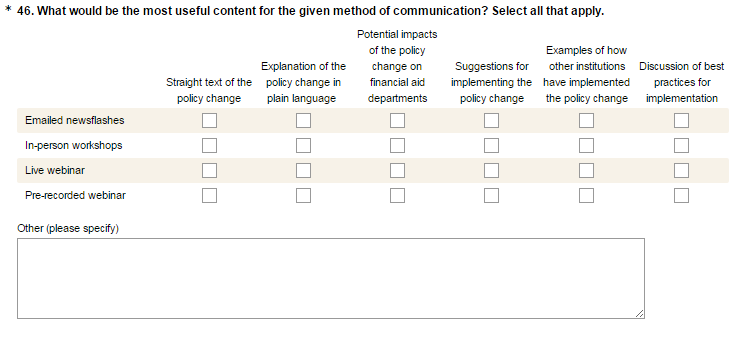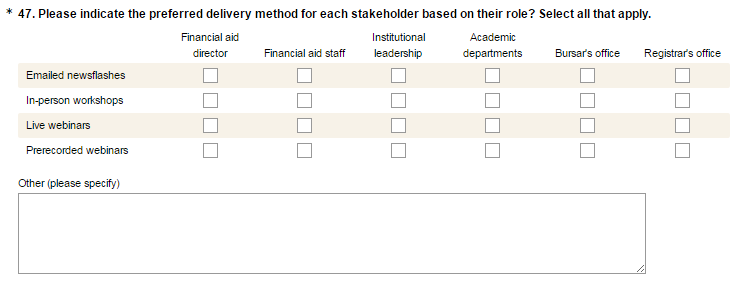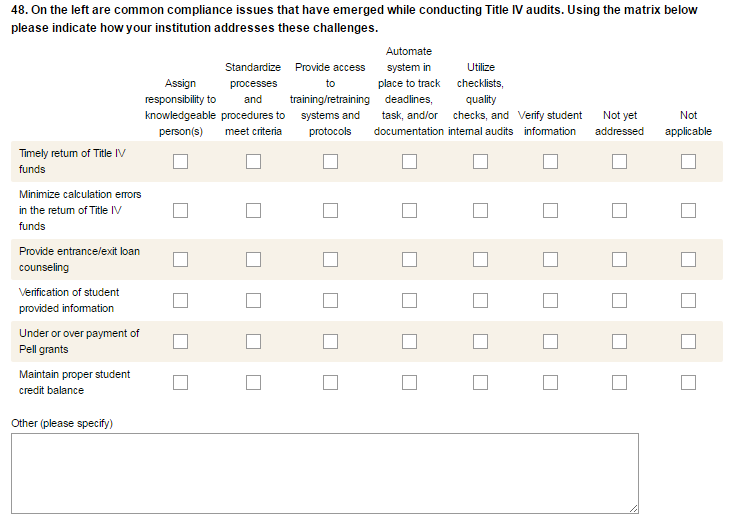MSURSD Risk Management Survey
Generic Clearance for Federal Student Aid Customer Satisfaction Surveys and Focus Groups Master Plan
MSURSD Risk Management Survey January 2016
MSURSD Risk Management Survey
OMB: 1845-0045
Risk Management Survey Protocol
OMB Approval No.: 1845-0045
Expires: 08/31/2016
FSA MSURSD MSI Support
TASK 2.4A: Develop School Risk Confirmation & Management Tools
PRA Burden Statement
According to the Paperwork Reduction Act of 1995, no persons are required to respond to a collection of information unless such collection displays a valid OMB control number. The valid OMB control number for this information collection is 1845-0045. Public reporting burden for this collection of information is estimated to average 20 minutes per response, including time for reviewing instructions, searching existing data sources, gathering and maintaining the data needed, and completing and reviewing the collection of information. The obligation to respond to this collection is voluntary. If you have comments or concerns regarding the status of your individual submission of this survey, please contact Minority Serving and Under Resourced Schools Division at 830 First Street NE, Washington, DC 20202 directly. Note: Please do not return the completed survey to this address.
###SURVEY PAGE 1####
This survey is being conducted to assess the impact of current federal policy changes, as well as other educational proposals in financial aid offices at minority serving institutions. We are exploring the impact of these policies/proposals and not your knowledge of these policies/proposals. In order to facilitate this goal, the link below will take you to a webpage that has a short description of each current or potential policy along with the dates that the policy was passed and implemented if applicable. We recommend opening the link in another window and keeping it open so you can easily refer to it throughout the survey. Thank you for your participation!
Rank the policies below based on the level of impact they've had at your institution or the level of impact that you anticipate they will have. For the purposes of this question, impacts include shifts in operations & procedures and new and/or updated training requirements. Place the policy that's had or potentially will have the largest impact first and smallest impact last.
Press and hold your mouse on any policy, and drag it up or down to change its rank.FAFSA® Early Submission
Gainful Employment Reporting and Enrollment Reporting
Free Community College
Borrower Repayment
New user-selected FSA ID to replace Federal Student Aid PIN
Federal Perkins Loan Program Wind-down
Which of the following policies did you say had/will have the greatest impact?
FAFSA® Early Submission
Gainful Employment Reporting and Enrollment Reporting
Free Community College
Borrower Repayment
New user-selected FSA ID to replace Federal Student Aid PIN
Federal Perkins Loan Program Wind-down
Which of the following policies did you say had/will have the 2nd greatest impact?
FAFSA® Early Submission
Gainful Employment Reporting and Enrollment Reporting
Free Community College
Borrower Repayment
New user-selected FSA ID to replace Federal Student Aid PIN
Federal Perkins Loan Program Wind-down
Which of the following policies did you say had/will have the 3rd greatest impact?
FAFSA® Early Submission
Gainful Employment Reporting and Enrollment Reporting
Free Community College
Borrower Repayment
New user-selected FSA ID to replace Federal Student Aid PIN
Federal Perkins Loan Program Wind-down
###SURVEY PAGE 2####
How did you first hear about the [Q2] policy/proposal change?
Media outlets (e.g., newspaper, television, radio)
IFAP website
Social media (e.g., facebook, twitter, linkedin)
MSURSD
Colleagues at your institution
Colleagues at other institutions
Listserv (please specify) ________________
When did you first hear about the [Q2] policy/proposed change? (see the link if you are not exactly sure when it was passed/implemented)
I heard about the change before the policy was passed.
I heard about the change when the policy was passed.
I heard about the change after it was passed, but before it was implemented.
I heard about the change when it was implemented.
I heard about the change after it was implemented.
Which of the following processes has the [Q2] policy impacted (or do you anticipate the policy/proposal will impact)? Select all that apply.
Awarding money (e.g., appeals, loans, scholarships)
Student services (e.g., loan counseling, communication, debt calculation)
Internal operations (e.g., staff development, staff burnout, staff management, budget creation)
Data collection, including data used for disclosures and reports
Internal/external audits
Other (please specify):___________
If you selected one or more of the processes above, please briefly describe how the processes were impacted (or how you anticipate the processes will be impacted) by the policy/proposed change. Be specific about the change(s) you had (or will have) to make.
Specifically, which internal procedures did you update (or do you anticipate having to update) to comply with the [Q2] policy/proposal change? Select all that apply.
Standard operating procedures
Employee manual
Internally communicated changes (email or meetings)
Internal audit
Redesigned staff training
No formal changes instituted
Restructure data tracking/system processing
Altered cross campus collaborations (please specify):____________
For the procedures selected above, briefly describe the changes you made (or will have to make) in order to comply. List any training or software packages that were used (or that you anticipate using).
Which of the following groups were (or will be) impacted by the [Q2] policy/proposal change? Select all that apply.
Students
Parents of students
Institutional leadership (e.g., president/CEO, provost)
Academic departments
Campus offices (e.g., registrar, bursar)
Other (please specify):____________
Briefly describe how the policy/proposal changes impacted (or will impact) the groups you indicated.
Which resources, as provided by outside organizations (e.g., federal student aid, state/local governments, professional organizations), were/would be the most helpful when implementing the [Q2] policy/proposed change? Select all that apply.
Financial (e.g., grants, funds)
Technical (e.g., programs, software)
Informational (e.g., PowerPoints, brochures)
No additional resources provided
What additional resources, if any, would have been helpful (or would be helpful) to implement this policy/proposal change?
In your opinion, which of the following practices were negatively impacted (or will be negatively impacted) by the [Q2] policy/proposal change? Select all that apply.
Financial literacy training (e.g., workshops, courses, orientations)
Entrance/exit interviews
Career counseling (e.g., networking opportunities, practice interviews)
Mentoring/job opportunities (e.g., alumni partnerships, community partnerships)
Default management (e.g., outreach, incentives, payment plans)
No practices were negatively impacted
Other (please specify)
To the best of your knowledge estimate the amount of time the financial aid office has used (or will use) to institute this policy/proposal change (in hours). Type your response without the word "hours", rounded to the nearest whole number, and without a comma (e.g., 1234).
To the best of your knowledge estimate the amount of time you yourself have used (or will use) to institute this policy change (in hours) in your office. Type your response without the word "hours", rounded to the nearest whole number, and without a comma (e.g., 1234).
###SURVEY PAGE 3###
How did you first hear about the [Q3] policy/proposal change?
Media outlets (e.g., newspaper, television, radio)
IFAP website
Social media (e.g., facebook, twitter, linkedin)
MSURSD
Colleagues at your institution
Colleagues at other institutions
Listserv (please specify) ________________
When did you first hear about the [Q3] policy/proposed change? (see the link if you are not exactly sure when it was passed/implemented)
I heard about the change before the policy was passed.
I heard about the change when the policy was passed.
I heard about the change after it was passed, but before it was implemented.
I heard about the change when it was implemented.
I heard about the change after it was implemented.
Which of the following processes has the [Q3] policy impacted (or do you anticipate the policy/proposal will impact)? Select all that apply.
Awarding money (e.g., appeals, loans, scholarships)
Student services (e.g., loan counseling, communication, debt calculation)
Internal operations (e.g., staff development, staff burnout, staff management, budget creation)
Data collection, including data used for disclosures and reports
Internal/external audits
Other (please specify):___________
If you selected one or more of the processes above, please briefly describe how the processes were impacted (or how you anticipate the processes will be impacted) by the policy/proposed change. Be specific about the change(s) you had (or will have) to make.
Specifically, which internal procedures did you update (or do you anticipate having to update) to comply with the [Q3] policy/proposal change? Select all that apply.
Standard operating procedures
Employee manual
Internally communicated changes (email or meetings)
Internal audit
Redesigned staff training
No formal changes instituted
Restructure data tracking/system processing
Altered cross campus collaborations (please specify):____________
For the procedures selected above, briefly describe the changes you made (or will have to make) in order to comply. List any training or software packages that were used (or that you anticipate using).
Which of the following groups were (or will be) impacted by the [Q3] policy/proposal change? Select all that apply.
Students
Parents of students
Institutional leadership (e.g., president/CEO, provost)
Academic departments
Campus offices (e.g., registrar, bursar)
Other (please specify):____________
Briefly describe how the policy/proposal changes impacted (or will impact) the groups you indicated.
Which resources, as provided by outside organizations (federal student aid, state/local governments, professional organizations), were/would be the most helpful when implementing the [Q2] policy/proposed change? Select all that apply.
Financial (e.g., grants, funds)
Technical (e.g., programs, software)
Informational (e.g., PowerPoints, brochures)
No additional resources provided
What additional resources, if any, would have been helpful (or would be helpful) to implement this policy/proposal change?
In your opinion, which of the following practices were negatively impacted (or will be negatively impacted) by the [Q3] policy/proposal change? Select all that apply.
Financial literacy training (e.g., workshops, courses, orientations)
Entrance/exit interviews
Career counseling (e.g., networking opportunities, practice interviews)
Mentoring/job opportunities (e.g., alumni partnerships, community partnerships)
Default management (e.g., outreach, incentives, payment plans)
No practices were negatively impacted
Other (please specify)
To the best of your knowledge estimate the amount of time the financial aid office has used (or will use) to institute this policy/proposal change (in hours). Type your response without the word "hours", rounded to the nearest whole number, and without a comma (e.g., 1234).
To the best of your knowledge estimate the amount of time you yourself have used (or will use) to institute this policy change (in hours) in your office. Type your response without the word "hours", rounded to the nearest whole number, and without a comma (e.g., 1234).
###SURVEY PAGE 4###
How did you first hear about the [Q4] policy/proposal change?
Media outlets (e.g., newspaper, television, radio)
IFAP website
Social media (e.g., facebook, twitter, linkedin)
MSURSD
Colleagues at your institution
Colleagues at other institutions
Listserv (please specify) ________________
When did you first hear about the [Q4] policy/proposed change? (see the link if you are not exactly sure when it was passed/implemented)
I heard about the change before the policy was passed.
I heard about the change when the policy was passed.
I heard about the change after it was passed, but before it was implemented.
I heard about the change when it was implemented.
I heard about the change after it was implemented.
Which of the following processes has the [Q4] policy impacted (or do you anticipate the policy/proposal will impact)? Select all that apply.
Awarding money (e.g., appeals, loans, scholarships)
Student services (e.g., loan counseling, communication, debt calculation)
Internal operations (e.g., staff development, staff burnout, staff management, budget creation)
Data collection, including data used for disclosures and reports
Internal/external audits
Other (please specify):___________
If you selected one or more of the processes above, please briefly describe how the processes were impacted (or how you anticipate the processes will be impacted) by the policy/proposed change. Be specific about the change(s) you had (or will have) to make.
Specifically, which internal procedures did you update (or do you anticipate having to update) to comply with the [Q4] policy/proposal change? Select all that apply.
Standard operating procedures
Employee manual
Internally communicated changes (email or meetings)
Internal audit
Redesigned staff training
No formal changes instituted
Restructure data tracking/system processing
Altered cross campus collaborations (please specify):____________
For the procedures selected above, briefly describe the changes you made (or will have to make) in order to comply. List any training or software packages that were used (or that you anticipate using).
Which of the following groups were (or will be) impacted by the [Q4] policy/proposal change? Select all that apply.
Students
Parents of students
Institutional leadership (e.g., president/CEO, provost)
Academic departments
Campus offices (e.g., registrar, bursar)
Other (please specify):____________
Briefly describe how the policy/proposal changes impacted (or will impact) the groups you indicated.
Which resources, as provided by outside organizations (federal student aid, state/local governments, professional organizations), were/would be the most helpful when implementing the [Q2] policy/proposed change? Select all that apply.
Financial (e.g., grants, funds)
Technical (e.g., programs, software)
Informational (e.g., PowerPoints, brochures)
No additional resources provided
What additional resources, if any, would have been helpful (or would be helpful) to implement this policy/proposal change?
In your opinion, which of the following practices were negatively impacted (or will be negatively impacted) by the [Q4] policy/proposal change? Select all that apply.
Financial literacy training (e.g., workshops, courses, orientations)
Entrance/exit interviews
Career counseling (e.g., networking opportunities, practice interviews)
Mentoring/job opportunities (e.g., alumni partnerships, community partnerships)
Default management (e.g., outreach, incentives, payment plans)
No practices were negatively impacted
Other (please specify)
To the best of your knowledge estimate the amount of time the financial aid office has used (or will use) to institute this policy/proposal change (in hours). Type your response without the word "hours", rounded to the nearest whole number, and without a comma (e.g., 1234).
To the best of your knowledge estimate the amount of time you yourself have used (or will use) to institute this policy change (in hours) in your office. Type your response without the word "hours", rounded to the nearest whole number, and without a comma (e.g., 1234).
###SURVEY PAGE 5###
Rank the methods of communication that would be most helpful to you for finding out about future policy/proposal changes.
Press
and hold your mouse on any policy/proposal, and drag it up or down to
change its rank.
Newsflash (email)
Workshop (in-person)
Live webinar (online)
Prerecorded webinar (online)
Website
Newsletter
Are there any other methods of communication that you would find helpful for finding out about future policy/proposal changes?


###SURVEY PAGE 6###
Which of the following best characterizes your institution type?
2 year Public
2 year, Private
4 year, Public
4 year, Private
What is your MSURSD cluster category?
Asian American and Native American Pacific Islander Serving Institutions (AANAPISI)
Alaska Native and Native Hawaiian Serving Institutions (ANNH)
Historically Black Colleges and Universities (HBCU)
Hispanic Serving Institutions (HSI)
Tribally Controlled Colleges and Universities (TCU)
Predominantly Black Institutions (PBI)
Not sure
Other: _________________
What is your IPEDS geographic region?
New England (CT, ME, MA, NH, RI, VT)
Mid-East (DE, DC, MD, NJ, NY, PA)
Great Lakes (IL, IN, MI, OH, WI)
Plains (IA, KS, MN, MO, NE, ND, SD)
Southeast (AL, AR, FL, GA, KY, LA, MS, NC, SC, TN, VA, WV)
Southwest (AZ, NM, OK, TX)
Rocky Mountains (CO, ID, MT, UT, WY)
Far West (AK, CA, HI, NV, OR, WA)
Outlying areas (AS, FM, GU, MH, MP, PR, PW, VI)
|
|
|
| File Type | application/vnd.openxmlformats-officedocument.wordprocessingml.document |
| Author | Beth Grebeldinger |
| File Modified | 0000-00-00 |
| File Created | 2021-01-24 |
© 2026 OMB.report | Privacy Policy
